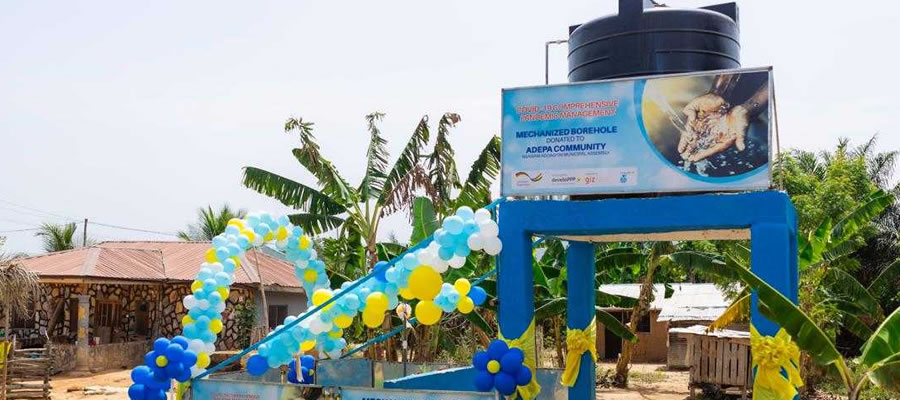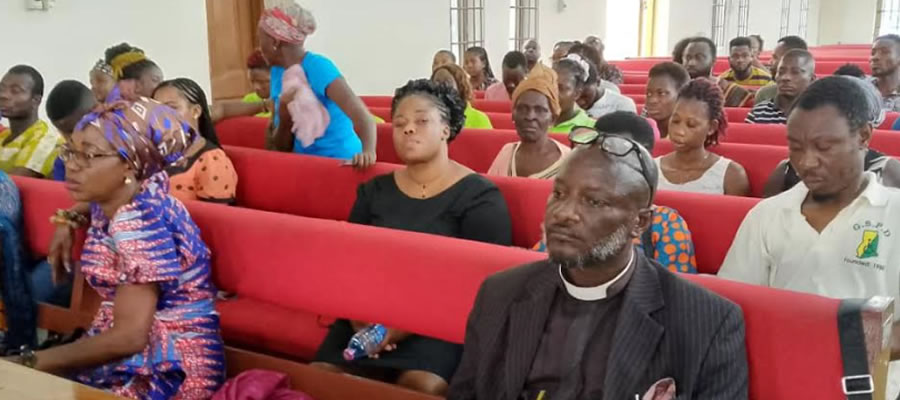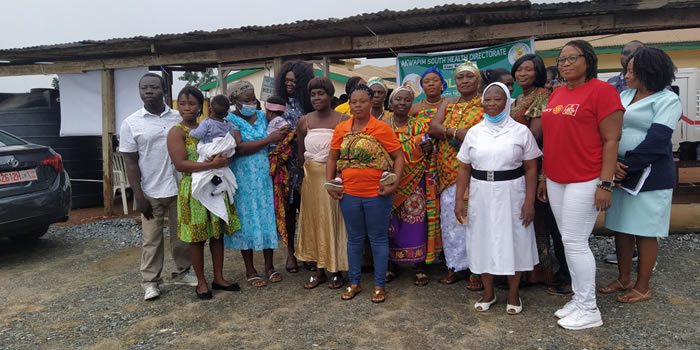

Agriculture; Farming Sub-sector
More than one third of the labour force is employed in the agriculture sector with majority engaged in crop farming. The District is one of the leading producers of pineapples, mangoes and citrus fruits in the country. Most of these farm produce are exported outside the country. There are also peasants who cultivate foodstuff as well as few other commercial farmers. Food crops that are cultivated include maize, cassava, plantain and vegetables, whilst livestock reared are poultry, sheep, goats, pigs, cattle and non-traditional animals such as grass cutters.
a. Farm Labour
Three forms of labour are employed in farming within the district. These are 60 percent rely on family labour, 30 percent hired labour, and 10 percent rely on the "Nnoboa" system to obtain labour for farming. According to the baseline survey conducted in the district, all respondent farmers reported of shortage of labour at one stage or other in their farming activities. It is more pronounced during land clearing and weeding periods. Most farmers walk between 2-5 kilometers to their farms. This is mainly because large tracts of fertile lands are located farther away from the settlements, as closer lands to the settlements have been worked out.
b. Access to Land and Security of Tenure
Land is vital in the development of agriculture and measures put in place to ensure effective administration of land resources go a long way to ensure agricultural development of a particular area. In a situation where land issues are fraught with problems, it invariably affects agricultural development in the area. Three methods of land acquisition are identified in the district. These include acquisition through inheritance (73.6 percent of the crop farmers), rent/leasehold (5 percent of the crop farmers), and abunu/abusa (share cropping) systems (21.4).
Under the abunu/abusa system of land acquisition, the land is given out after which the proceeds from the land are divided into two or three between the landowner and the farmer. Land acquired through the abunu/abusa system does not encourage young people to go into farming. There is therefore the need for the assembly to intervene by leasing unused government lands or acquiring lands to people who are willing to go into agriculture but has issues with acquiring lands. This is necessary because of the increase need of land for other purposes other than agriculture.
Inadequate land tenure is still a major obstacle to ensuring sustainable agriculture and rural development in the district. The growth in large-scale, export-oriented production can exacerbate the marginalization of subsistence farmers, and encourage the further displacement of indigenous peoples. Increasing privatisation of land and natural resources associated with this shift can also increase the process of urban migration. Much of food production is oriented to the export market of cereals and grains.
The ownership of land and the food industry lies increasingly in the hands of a small number of intensive farmers/producers, with the consequent social and environmental impacts. Facilitating a transition to small-scale production for local markets will require a change of land tenure which can be a difficult process of change.
Although men can be key workers in the agricultural sector, women remain the dominant producers of food in subsistence agriculture for the district. Women’s access to and ownership of land is also limited in the district
c. Sizes of Farm
About 44 percent of crop farmers have farms between 1-3 acres with about 20 percent of individual holdings below 1 acre. A total of 52 percent (115.3 km2) of the total land of the district is under cultivation. Farmers with more than 3 acres of farmland are mostly farmers cultivating Pineapple and other crops such as citrus and vegetables. The crop sub-sector is largely subsistent since individual holdings are very small. This assertion is also supported by the cumbersome land tenure arrangement in the district where individuals obtain land for farming largely through inheritance. Efforts must therefore be made to intensify and mechanize the available agriculture farms while at the same time encouraging access to land by the private sector especially women. If this is not done, the food basket of the district will reduce which implies an increase in importation of food from other Districts or Region.
d. Major Crops and Output Levels
The major food crops grown in the District include maize, cassava, plantain, cocoyam and yam. Table 6 shows the major crops and their output levels from 2014- 2016. In terms of productivity per hectare, the tuber crops (yam and cassava) are relatively doing better than the other food crops. Apart from the above crops, other minor crops like vegetables such as okro, tomatoes, garden eggs, cabbage and pepper are often intercropped with the major crops and use as food supplements.
It is observed from Table 6 that the acres of land used for the cultivation of the major staples (Pineapple, maize, Plantain and cassava) decreased averagely by 5% over the period, thereby affecting the total production of the food crops except plantain. The reduction in the acres of land used for cultivation can be attributed to the conversion of arable lands into estate developments. Pineapple production however, did experience a zero increment or reduction in its output for the period.
Table 6 shows that an increase in arable lands for the production of a particular crop resulted in a proportionate increase in the total production yield of that particular crop. This means that, all other things being equal, the total area of land used for the production of a particular crop greatly influences the outcome of that crop in the Akwapim South District implying that the designated bodies authorized to distribute land uses should try their best to protect agriculture lands from being converted into estate lands.
e. Incidence of Pests and Diseases
The incidence of diseases and pests on a particular farm largely affects the output produced. In the Akwapim South District, the common crop diseases found in the area include black pod and swollen shoot which affect cocoa; maize smut; cassava mosaic and pests such as termites, maize borers, rodents, nematodes and grass cutters.
Mass Spraying exercise being implemented by the government for cocoa has been truncated, while other crops have been neglected altogether. This may lead to loss of food crop plants or harvest which in the end may discourage people from going into farming activities.
f. Access to Extension Services
Extension services, as these institutions are usually called, provide the key link between the research laboratories or experimental farms and the rural population that must ultimately adopt what the laboratories develop. They advise farmers on new techniques of farming such as row planting, proper use of agro chemicals, improve crop varieties, seed planting, material production and multiplication techniques; disease and pest surveillance, post-harvest handling and soil fertility improvement and management among others.
There are four extension zones in the district and each zone is entitled to two extension officers bringing the total number of extension agents in the district to eight (8). The Agriculture Department would require 12 extension officers. Inadequate motorbikes, lack of motorbike maintenance allowances, inadequate training (capacity building) for staff, low motivation (including travelling and transport allowance) are some major challenges that affect the operation of extension officers in the district.
g. Financing Agriculture and Access to Credit Facility
Financing of farming activities in the district is largely from personal savings. About 80 percent of the farmers rely on this form of financing their farming business perhaps, because majority are into subsistence farming and or have no access to credit facilities.
As savings are very low, capital formation becomes difficult. Even though there are financial institutions such as GCB, Akwapim Rural Bank and other credit facilities available in the district, farmers are not willing to take loans because of the associated high interest rate, lack of collateral security and other lending policies.Other sources of finance for the agriculture sector are farmers’ relatives and moneylenders. Notwithstanding these problems, adequate financial capital is crucial to the development of agriculture in every agrarian economy. This is needed for the purchase of agriculture inputs needed for farming. Such inputs include agro chemicals, hiring of labour and buying improved seedlings. In the Akwapim South District, the survey reveals that 85 percent of the farmers have no access to credit.
It is however realized that, areas where the banks have been successful with loan disbursement are areas of group loan facilities. Farmers who do not have access to credit facilities or enough money to finance their farming activities will be compelled to produce on subsistence basis. Farming on subsistence level will not solve the poverty situation of farmers in the District. There is the need to encourage more group loans since it works better than personal loans in the area.
h. Storage of produce and post-harvest losses
For farmers to have the edge to produce more there must be available storage facilities. The availability of storage facilities will help farmers to store crops, which are not in high demand or that which are in excess. All other things being equal, with the hope of having a place to store produce, farmers can produce enough to meet production level.
It can then not be denied that the availability of storage facilities increases farmers’ morale to produce. However, 79 percent of the crop farmers do not have access to storage facilities. The 21 percent of farmers with access to storage facilities had storerooms, huts, coca sacks, maize sacks, drying boards or panels, shelves and mats at their disposal. The unavailability of appropriate storage facilities have led to post harvest losses in the district.
There are few small-scale agro-based processing industries like maize, cassava, palm oil as well as local processing juice companies such as Blue Skies and Nsawam Canary which are even located outside of the district.
Agriculture; Livestock and Animal Rearing Sub-sector
a. Animals Production
Livestock production is an important sub-sector under the agricultural sector. This is because it serves as a source of protein supplement in the food we eat and as a source of revenue to those engaged in animal rearing. The very little attention paid to this sub-sector affects productivity and hence, its low contribution to GDP. The survey reveals that, 2.5 percent of the farmers engaged in agriculture are into livestock production. Livestock such as goat, sheep, cattle,
turkeys and chicken are reared. Cattle production is very low since only few farmers keep them in kraals during the night and herdsmen follow them to grace during the daytime. Almost every household keeps local birds. Few pigs, ducks and grass cutters are also kept. However, the number of livestock kept in the district has been increasing since 2014. For instance, number of pigs kept has increased from 1,050 pigs in 2014 to 1,250 in 2016. The increase of livestock production manifest that livestock keeping play important role in increasing income and contribute to reduce poverty of the households.
b. Incidence of Pests and Diseases
Table 7 indicates that 33.3 percent of the livestock farmers complain of pest attacks, the remaining 66.6 percent have their animals being attacked by diseases of various kinds. The common pests affecting the animals include ticks and lice. The diseases on the other hand include foot and mouth disease, rabies, mange disease, new castle disease, gumboro disease, and tuberculosis. The pests and diseases are mainly controlled by injection, deworming and dipping. This increases the cost of production.
c. Urban Agriculture
Areas around Aburi operational area practise urban agriculture. They mostly engage in livestock production (poultry, sheep and goat) and the production of vegetables. Urban Agriculture farmers are admonished to use animal droppings for their backyard gardens and farms.
There are very few plantation farms in the district. The biggest plantation is about 8-10 hectares. Land tenure system is the biggest challenge to the crop production in the district. Inadequate elaborate livestock housing leads to stray animals destroying crops of other households. Inadequate space and limited land is also another major challenge to urban agriculture in the district.
Date Created : 11/23/2017 2:41:16 AM











 facebook
facebook
 twitter
twitter
 Youtube
Youtube
 +233 593 831 280
+233 593 831 280 0800 430 430
0800 430 430 GPS: GE-231-4383
GPS: GE-231-4383 info@ghanadistricts.com
info@ghanadistricts.com Box GP1044, Accra, Ghana
Box GP1044, Accra, Ghana